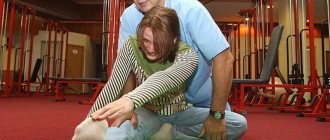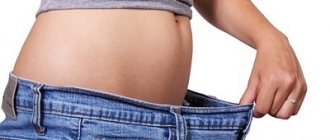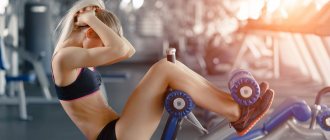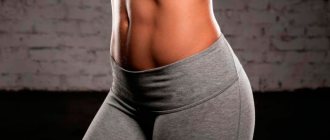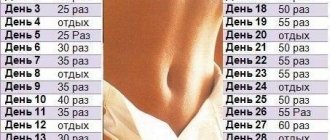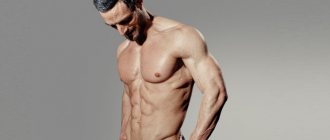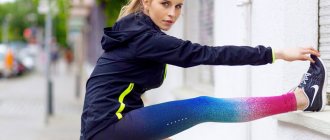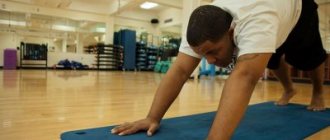How to strengthen your baby's abdominal muscles
How to find out at this age whether the child’s abdominal and back muscles have enough strength? What can cause incorrect posture formation? As we remember, muscle strength can vary in different muscle groups. To know how to strengthen your child's abdominal muscles, you need to test the abdominal muscles and back muscles in turn. Let's start with the abdominal muscles. Here you can see several deviations that will indicate underdeveloped abdominal muscles. The first thing parents usually notice is the protrusion of the child’s abdomen when he stands quietly. It is associated with muscle relaxation, and not with excess body weight. Let this be your first signal for testing and for starting classes with your baby.
Abdominal muscle testing
To determine whether your baby's abdominal muscle strength is sufficient, try the following: place a gymnastics mat on the floor. The baby should only be wearing panties; ask him to lie on the mat on his back; sit on the floor next to his feet. Place a small bolster, such as a baby blanket, under his knees to bend his legs at the knees and hips. Holding his legs at the ankle joints with your hands, ask the child to sit down. Get younger kids interested in this toy.
While your baby is moving, pay attention to the following three important points:
• The first is how easily the child can sit up. The weakest baby sits down only with your help. The baby can sit down a little stronger without you, but at the same time he helps himself with his hands, leaning them on the floor. The strongest baby, sits down without using his hands, using only the abdominal muscles.
• The second thing you should look at is the abdominal muscles as they contract, i.e. when the child sits down, they should contract evenly, and the tummy should be even. But you may notice a protrusion in the middle like a keeled stripe, just above the navel towards the sternum. This usually happens with weakness of the so-called. linea alba. (The linea alba is formed as a result of the intersection of the fibers of the ligaments of the broad abdominal muscles on opposite sides. The described intersection of fibers forms a strong septum containing very few vessels - the linea alba. - Author's note).
• The third thing to pay attention to during movement is the last ribs of the chest. Part of the abdominal muscles is attached to them. During their contraction, when the child tries to sit up, the ribs can turn outward, changing the shape of the chest. This may be indirect or additional evidence of rickets. With well-developed muscles and strong ribs, visible deformations should not occur during movement.
And the last important point for assessing the condition of the abdominal press is the condition of the umbilical ring. (The umbilical ring is a hole in the linea alba of the abdomen, formed by the fibers of the ligaments of all the broad abdominal muscles. - Author's note). Due to the lack of muscle cover, the navel is another weak point in the abdominal wall, where umbilical hernias often occur. The younger the child, the more vulnerable this area is. An umbilical hernia is the result of weakness in this area. Therefore, it is better to determine in advance whether there is weakness of the umbilical ring, and correct the situation with the help of massage and therapeutic exercises,
Push ups
Effect: the muscles of the arms and chest are strengthened. It is important to do push-ups after squats in order to unload the leg muscles and load the upper shoulder region - this will evenly distribute the load on different muscles.
Technique:
- depending on the width of your arms, you can choose the load: if your arms are close to each other, then the biceps are worked, if the arms are spread wide, the chest is worked
- the body should be in a straight position, only the arms are bent
- perform a maximum of 10 times
- Another option is to smoothly lower yourself to the floor in this order - knees, pelvis, body, you also need to smoothly go up to the starting position
Exercise No. 8. “Jumping Jack” lying down
Works the shoulders, abdominal muscles and buttocks.
- Lie on your right side, resting on your elbow. Raise your left arm up, left leg extended, toe pointed down.
- Start lowering your outstretched arm down until it is at a 45 degree angle. At the same time as your hand, raise your left leg, continuing to hold your foot in the same position.
- Return to starting position and repeat.
Complete 12 reps and repeat on the other side.
Burpee
Effect : development of general endurance. The work includes the legs, abs, body, and arms. Performed in six stages.
Technique:
- starting position - standing
- crouching emphasis
- jumping with two legs while lying down
- lie down completely on the floor and do a push-up
- pull your legs to your chest, once again finding yourself in a crouched position
- jump up, clapping your hands above your head while jumping
- perform 10 times
At the initial stage, you need to achieve correct execution, then gradually increase the pace during the exercise.
Press
Technique:
- starting position - lying on your back, legs straight, arms behind your head or arms straight along the body
- the child stretches his arms first, creating inertia, then his head and shoulders rise, twisting is done gradually, with his hands he reaches his toes - so that at this moment of stretching he can rest
- smoothly lower back
- You cannot fall sharply backwards with your straight body and rise sharply forward
- for ease of execution, you can hold the child’s feet or hook the socks to the base of the sofa so that the feet do not come off the floor when lifting
- perform 10–15 times
Throwing your legs over your head
Effect: the lower abs are strengthened, the lumbar region is stretched.
Technique:
- starting position - lying on your back
- Gradually raise your legs and throw them over the line of your head
- the emphasis is on the shoulders, not on the neck and head
- perform 10–15 times
IMPORTANT: while practicing at home, it is necessary to maintain a drinking regime - no more than one or two sips of water at intervals of two exercises; in total, the child should drink one and a half liters of water per day. It is better to eat one and a half to two hours before class and fill your food with complex carbohydrates. After class, the child needs to eat, but not earlier than 30–40 minutes later.
Praise be to the hula hoop!
The hula hoop is the perfect waist trainer. Firstly, when working with it, a huge number of different muscles are involved, which you train by performing just one exercise. Secondly, no one has canceled the positive effects of massage. By touching your body, the hoop increases blood circulation, due to which all processes, including weight loss, proceed at an accelerated pace.
And the hula hoop mechanically destroys fat deposits, which are eliminated through the lymph and bloodstream. True, all these wonderful processes will start only if you choose the right hoop. It is clear that the heavier the hula hoop, the higher the load, but this is not a reason to start training with a metal circle. The fact is that you are unlikely to be able to spin it for an hour; it will be too difficult if you are not used to it. If contact with the hoop takes less time, no positive changes will simply occur. Therefore, without further ado, give preference to the simplest, plastic hula hoop, and when you get used to it, switch to an iron one.
As for newfangled hoops with weights and “spikes,” it’s better not to get carried away with them. Yes, of course, with such hula hoops the load is higher, but it increases not only on the muscles, but also on the spine, and this is harmful. In addition, such hoops injure the body (the sides and back become covered with bruises after contact with them) and even internal organs. In general, if you do not want to harm yourself, instead of a heavy but unsafe hula hoop, twist two iron ones at the same time. Believe me, the load will be no less.
And most importantly, try to rotate the hoop correctly: do not bend your knees, as most young ladies do, work only with your body. Don't forget, you're not building your legs, but your waist.
Abdominal strengthening exercises for little ones
Let's start by considering a set of exercises that is suitable for children aged 4, 5, 6, 7 years. At this age, the muscle corset is still very weak, so any load should be insignificant. Strictly speaking, it’s too early to pump up abs for a 3-year-old child. All strength training for preschoolers comes down to light physical exercise, but you can carefully shift the load on the abs with the help of certain exercises:
- Bike. The first simple exercise that children 4-6 years old and older like. The child should sit on the floor and place his hands on the floor behind his back to maintain balance. Then you need to raise your legs off the floor and begin to perform movements with them that imitate the rotation of bicycle pedals. The duration of the exercise is 10-15 seconds.
- Legs up. Static abdominal exercise, safe for children under 6-8 years old. The starting position is the same, but now the child must raise his straightened legs above the floor and hold them for 8-15 seconds, depending on physical fitness.
- Scissors. The starting position is the same, but now the legs raised and straightened at the knees need to be crossed in the horizontal axis, imitating the work of scissors. The exercise lasts 8-12 seconds.
- Leg raises with a ball. We do not change the initial position, but now the child must hold a small ball between his feet. Together with him, he should raise and lower his legs, but not lower them to the floor. 10-12 seconds is enough.
What experts say
Doctors strongly recommend that children not be exposed to physical exercise until they are 12 years old. This is due to the fact that before hormonal changes, children have little protein in their bodies, so the muscles quickly get tired, and the risk of intervertebral hernia is quite high.
Children can pump up their abs starting from the age of 12, only the exercises performed should be based on lifting their own weight, they cannot work with weights at this age. And in general, children under 16 years old should not pump up their abs with additional equipment. And then, you can learn in more detail how to properly pump up the abs for beginners with weights.
It is better to start with the simplest exercises, for example, on an abdominal plank. For boys, you can start training a little earlier - at 14-15 years old.
But, nevertheless, it is better to choose sports sections where all muscle groups develop, such as swimming, volleyball, dancing and others.
You need to know that children need to pay special attention to strengthening their back, because a strong muscular corset of the spine is the basis for the health of the whole body.
To know how to properly pump up the abs for children, it is better to start their first workouts under the supervision of a professional trainer who can monitor the entire training process.
Abdominal exercises for schoolchildren
This set of exercises is suitable for older children - 8, 9, 10 years old. Even at 12-14 years old, it will help a child strengthen his abdominal muscles. Moreover, parents can practice this program in parallel with their children, but perform a greater number of repetitions. So, the complex includes the following exercises:
- Twisting. You need to lie on the floor with your knees bent at approximately 90 degrees. Hands should be crossed over the chest or folded behind the head. From the initial position, the child must twist his torso, lifting his shoulder blades off the floor and lifting his body. The main thing is to explain to him that his lower back should be pressed to the floor, and watch this carefully. Otherwise, the spine will receive a load that is harmful to it. You need to perform 15-20 repetitions or more, if physical fitness allows.
- Leg raises. Lying with his back on the floor, the child needs to alternately raise and lower his legs. They should be straightened at the knees, and they should not be lowered until the feet touch the floor. It is necessary to perform 10-15 movements with each leg.
- Book. Starting position lying on the floor. You need to simultaneously raise your legs and torso, as if folding your body. The exercise is not easy, but very effective and most importantly safe for the spine. 10-12 repetitions are enough.
- Hanging leg raises. Older children (after 11-13 years) can perform an exercise to pump up the abs on the horizontal bar. You need to hang on the bar and begin to raise your bent legs, pulling your knees to your chest. The exercise is hard, but it does not strain your back and strengthens your grip. 8-10 repetitions are enough.
Finally, we note that abdominal exercises, like any other physical activity, are allowed for children only if there are no health problems. Otherwise, you can harm the child's body.
Sources:
https://massageonline.ru/2017/09/kak-ukrepit-myshcy-zhivota-rebenka/ https://www.yapokupayu.ru/blogs/post/ofp-dlya-rebenka-6-prostyh-uprazhneniy-kotorye- mozhno-delat-doma https://www.sportobzor.ru/press/uprazhneniya-dlya-pressa-dlya-detey.html
How to pump up abs for a teenager at home: exercises
To get a toned figure, abdominal exercises alone will not be enough - you will need to regularly perform complex workouts.
For a child under 16 years of age, it is better to practice swimming using various styles. You need to go to the pool at least twice a week for 45 minutes.
Strength training cannot be started before the age of 16, otherwise the teenager risks stunting.
For home workouts in order to keep the body in good shape, it is recommended to do the following set of exercises:
- Do push-ups from the floor or from an elevated surface with your stomach pulled in.
- “Bicycle” with legs raised 90° to the floor. Spin imaginary pedals in the air and suck in your stomach.
- Bend from a standing position back and forth and from side to side. This will strengthen your abdominal muscles.
- Raise your legs from a lying position as follows: bend your knees and press them to your stomach, slowly straighten them and lower them.
- Pump your abs, lifting your body and legs at the same time to create a 90° angle. How to pump up your abs correctly in the “book” exercise? Try to touch your legs with your hands so that the pose resembles a closed book.
If you balance your diet and regularly do comprehensive exercise, you will see a positive result in a few weeks.
